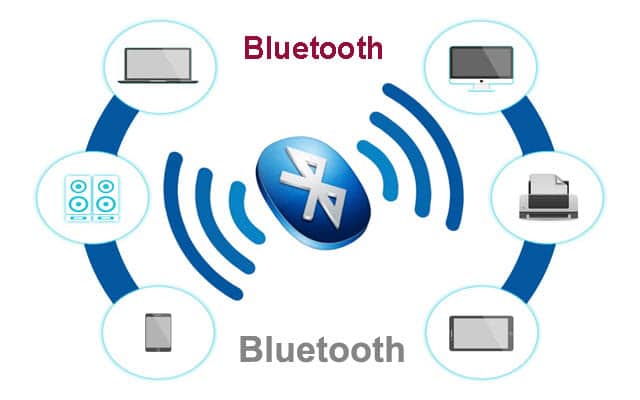Humans have invented many technologies to help us stay connected with our friends and family, and although some of these technologies have disappeared and are no longer in use, Bluetooth is still one of the most common technologies used, which is a wireless communication method via radio signals. We use wireless Bluetooth technology a lot in our daily lives, for example, it connects our headsets, mouse, and keyboard to our computer, and we connect our smartphone to the music device in our cars to listen to music directly from the phone or receive and make phone calls.

Points to keep in mind
With the development of wireless devices, “Bluetooth technology” has become one of the pillars of the communication process between the devices, especially that we see it very available when we use the phone via small wireless headphones placed in the ear and connected to the phone.
There are several important points to consider when connecting two devices to each other.
Physical first point: Will the two devices communicate over wires or via radio signals? In the case of wires, how many wires are required to achieve the connection? One, two or more? If you come to the physical characteristics of the connection, many other questions arise:
- How much data can be sent per unit of time? For example, serial ports transmit 1 bit per unit of time, while branch ports transmit several bits.
- How will the two devices communicate? The two parties to the communication in this electronic dialogue must know what the decision means, and whether each party received the same message that the other party sent. This means developing a set of commands and responses known as protocols
Bluetooth technology gives us the answers to these questions. We will learn more about Bluetooth technology in this article. Let’s discover how Bluetooth technology works and how to establish a wireless connection.
How does Bluetooth establish connectivity?
Bluetooth technology takes small area networks to the second level that doesn’t need user intervention and uses very low transmission power to save battery power. This is considered one of the basic techniques in the standard of networks that operate at two levels:
- Ensures compatibility at the physical level and form a radio-frequency standard.
- Ensures compatibility at the protocol level used, so that both parties make sure that the message received is the same as the one that was sent.
The great advantage of Bluetooth is that it is a cheap automatic wireless connection. But there are other ways to avoid using wires such as infrared communication.

Infrared (IR)
Infrared (IR) is light waves with a lower frequency than the eye can receive and translate, and is used in most TV control devices.
This type of communication is somewhat reliable and inexpensive, but its use is hampered by two things: First, infrared communication technology is a line-dependent technology that provides Line Of Sight availability.
That is, you have to point the device to the TV or video player. Another obstacle is that infrared technology allows one to one communication.
It does not enable data to be sent, for example, from your computer to your mobile device and tablet device at the same time, but rather from your computer to only one device.
Of the advantages of infrared radiation
The infrared connection has many advantages. The infrared transmitters and receivers must be aligned, which makes interference between them rare. The nature of the infrared communication between two devices makes you sure that the message has only gone to the intended device, even if the room is full of other receivers.
But Bluetooth technology outperforms the infrared system with many advantages. It can connect to multiple devices, and does not require a line of sight between devices in order to function. Let’s find out how Bluetooth networks work.
How does Bluetooth work?
Bluetooth networks send data via low-power radio waves, at a frequency of 2.45 GHz (for the accuracy of 2.400-2.483 GHz), which is within the internationally agreed frequencies for use in industrial, scientific and medical devices (ISM bands).
The same frequency may be used in some other devices, as baby monitors, garage door openers and the new generation of mobile phones use the same ISM frequency band. Ensuring that Bluetooth technology did not interfere with these devices was a major challenge.
According to technologists, this technology is used in a range greater than 3,281 feet (1 km), but to avoid Bluetooth devices interfering with other systems it sends very low power signals (about 100 milliwatts) and therefore the range of work for Bluetooth devices does not exceed 656.2 feet (200 meters) This prevents interference between your computer system, your mobile phone, or your TV. Even with this low energy use, Bluetooth technology does not require a line of sight between connected devices, and the walls do not prevent the passage of Bluetooth signals, enabling us to control devices located in different rooms of the home.
Bluetooth capability
Modern Bluetooth technology can handle many devices at the same time. You might think that devices within 10 meters will overlap, but that doesn’t happen. Bluetooth makes use of the era of spread spectrum frequency hopping, which prevents it from sending a couple of message device at an identical frequency at the identical time. In this technique, devices will use 79 random frequencies chosen within a certain range and change from one frequency to another regularly.
When using this technology in Bluetooth, the transmitter changes the frequency 1600 times every second, which means that the devices use the full range of their radio spectrum. Since each transmitter uses automatic spectral scattering, it is unlikely that two transmitters will transmit the signal at the same frequency at the same time. This technology reduces the risk of interference from mobile devices and baby monitors with Bluetooth devices, although any possible interference will last only a fraction of a second.
When Bluetooth devices operate in a common range, electronic conversation plays a role in determining whether these devices have data to share or whether one needs to control the other. The user does not have to do anything, move any button or give any command, the conversation will run automatically and automatically. Upon completion of the electronic conversation, a special network is built between these devices, even if they are part of the computer system or the amplifier.
Bluetooth systems build a Personal Area Network or the so-called piconet that may fill the room or may only include the distance between your mobile phone and headphones. Once the private network is established, random frequency hops maintain harmony and compatibility between the two devices and avoid other networks in the same room. Let’s take a look at an example of a Bluetooth calling system.
The work of this technique
First of all, Bluetooth technology works on smartphones and wireless earphones.
Imagine a typical living room with typical modern furniture. The room is an entertainment system, DVD player, TV, smart subwoofer, smartphone, wireless landline, and laptop. All these devices use Bluetooth technology, and each of them forms its own network to communicate with its basic unit.
The wireless phone has a Bluetooth signal transmitter on its fixed base and on the speaker as well. The manufacturers have programmed each transmitter with an address and detail within the domain designated for a specific type of device. Radio signals send their request to respond to an address when the phone base begins operating. As long as the speaker contains an address located in this field, it responds to the request, which creates this small network. Consequently, these devices refuse to receive any signal from another system that does not belong to the same network.
The computer and the entertainment system perform the same process, as they each form networks through addresses within the fields specified by the manufacturers. Once these networks are established, the systems begin to communicate. Each network performs frequency hopping within the frequencies available to it and remains independent of other networks.
Now the living room has 3 separate private networks, each consisting of devices that know the address of the transmitters that they must listen to and the receivers they must communicate with. And since each network changes the frequency at which it runs thousands of times per second, it is unlikely that two networks operate on the same frequency at the same time. If there is interference, it will only last for a few seconds, then programs designed to correct errors will cancel the wrong information and continue to perform network work.

– Security in Bluetooth:-
Without a doubt, information security is a major concern when creating any wireless network. Devices read radio signals easily, so those who send sensitive information over the wireless network must take care to ensure that these signals will not be intercepted.
Bluetooth technology does not differ from wireless networks, as it is vulnerable to penetration and spying on it, as it can be accessed remotely, and it is also subject to interception, especially if it is a network that is not well protected, for example, Wi-Fi technology that automatically connects to Bluetooth technology They are vulnerable to exploitation, and through this breach, you can send data to you without permission.
Bluetooth technology provides connection security in a number of ways, and device manufacturers determine the security model it contains. In most cases, the user can determine which (trusted devices) can transmit data without permission, and when a device tries to connect to Bluetooth the user decides whether or not it is allowed. service-degree protection and tool-stage safety work together to protect the tool from unauthorized information.
Safety methods
Security methods include authorization and identification procedures and require the user to specify the type of service (opening or moving files). As long as these measures are available to the user’s phone and his or her contacts, it is not likely that an unauthorized transfer of data will occur. The user can simply switch the Bluetooth mode to (invisible), thereby avoiding communication with other Bluetooth devices altogether. One of the good ways to avoid any breach or spying is to use the Bluetooth network mainly to synchronize your home devices first-hand.
Despite all precautions, hackers who program viruses for unprotected phones may take advantage of the automatic Bluetooth connection to send corrupt files. Although the damage to these files will often be limited because any Bluetooth connection requires a permit and authentication process before accepting the transfer from any unknown device. The user’s mobile device (the smart device) will not be infected by the virus if it does not open or install it, preventing most viruses from causing damage to the cellular devices.
Bluetooth technology has caused some problems that have caused serious security issues, such as sending bluejacking messages, hacking blue bugging Bluetooth devices and penetrating the car’s Bluetooth device.
Spam is sent to other users in the domain, and although sensitive information does not appear, spam appears on your device. Unauthorized access to the Bluesnarfing device is similar to sending Bluejacking spam, but messages sent include a code that forces the receiver to reply, to send contact information again.
Bluebugging allows remote access to a user’s device and the use of its features, such as making calls and sending messages without the user realizing it. Blueborne hacking requires the owner of the target device to operate its device first, after which the hacker can control its screen and applications.
Exploiting penetration
The operation of the car Bluetooth device exploits the inability of car owners to change the PIN of the Bluetooth gadget (set by the manufacturer), allowing pirates to send and receive music clips from the device.
Such vulnerabilities are side effects of any technical innovation, and hardware manufacturers release security software updates that address new problems as they arise. The user can avoid hacking by changing the manufacturer’s PIN or default password, and making his Bluetooth network not visible to other devices.
Finally
Bluetooth technology must be one of the leading technologies and techniques that changed a lot in the course of this industry and the nature of our relationship and our dealings with devices, and also it is expected to have more in the future.
We at Hi4 Wireless are working hard to provide you with everything related to wireless technology and wireless technology. Hope you will support us and follow us continuously and leave your opinions and comments, and we will be happy to answer you …
***************

